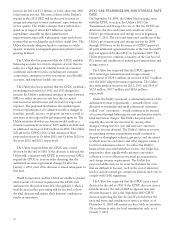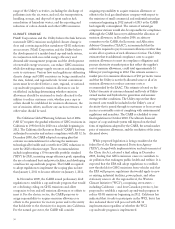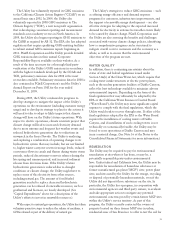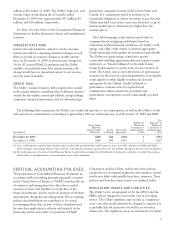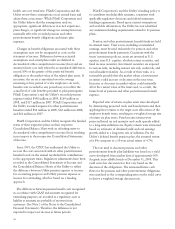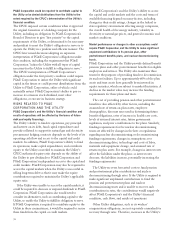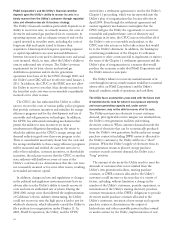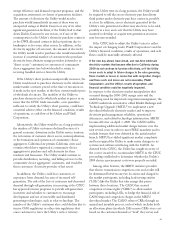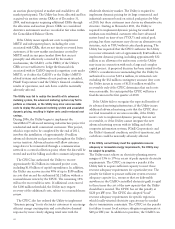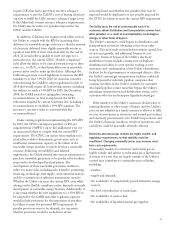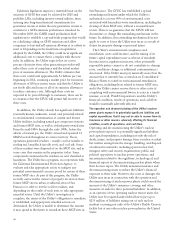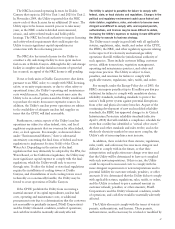PG&E 2009 Annual Report Download - page 42
Download and view the complete annual report
Please find page 42 of the 2009 PG&E annual report below. You can navigate through the pages in the report by either clicking on the pages listed below, or by using the keyword search tool below to find specific information within the annual report.PG&E Corporation could be required to contribute capital to
the Utility or be denied distributions from the Utility to the
extent required by the CPUC’s determination of the Utility’s
financial condition.
The CPUC imposed certain conditions when it approved
the original formation of a holding company for the
Utility, including an obligation by PG&E Corporation’s
Board of Directors to give “first priority” to the capital
requirements of the Utility, as determined to be necessary
and prudent to meet the Utility’s obligation to serve or to
operate the Utility in a prudent and efficient manner. The
CPUC later issued decisions adopting an expansive
interpretation of PG&E Corporation’s obligations under
this condition, including the requirement that PG&E
Corporation “infuse the Utility with all types of capital
necessary for the Utility to fulfill its obligation to serve.”
The CPUC’s interpretation of PG&E Corporation’s
obligation under the first priority condition could require
PG&E Corporation to infuse the Utility with significant
capital in the future or could prevent distributions from the
Utility to PG&E Corporation, either of which could
materially restrict PG&E Corporation’s ability to pay or
increase its common stock dividend, meet other
obligations, or execute its business strategy.
RISKS RELATED TO PG&E
CORPORATION AND THE UTILITY
PG&E Corporation’s and the Utility’s financial condition and
results of operations will be affected by the terms of future
debt and equity financings.
The Utility’s ability to fund its operations, pay principal
and interest on its debt, fund capital expenditures and
provide collateral to support its natural gas and electricity
procurement hedging contracts depends on the levels of its
operating cash flow and access to the capital and credit
markets. In addition, PG&E Corporation’s ability to fund
its operations, make capital expenditures, and contribute
equity to the Utility as needed to maintain the Utility’s
CPUC-authorized equity ratio depends on the ability of
the Utility to pay dividends to PG&E Corporation and
PG&E Corporation’s independent access to the capital and
credit markets. PG&E Corporation may also be required to
access the capital markets when the Utility is successful in
selling long-term debt so that it may make the equity
contributions required to maintain the Utility’s applicable
equity ratio.
If the Utility were unable to access the capital markets, it
could be required to decrease or suspend dividends to PG&E
Corporation. PG&E Corporation also would need to
consider its alternatives, such as contributing capital to the
Utility, to enable the Utility to fulfill its obligation to serve.
If PG&E Corporation is required to contribute equity to the
Utility in these circumstances, it would be required to secure
these funds from the capital or credit markets.
PG&E Corporation’s and the Utility’s ability to access
the capital and credit markets and the costs and terms of
available financing depend on many factors, including
changes in their credit ratings, changes in the federal or
state regulatory environment affecting energy companies,
the overall health of the energy industry, volatility in
electricity or natural gas prices, and general economic and
market conditions.
Market performance or changes in other assumptions could
require PG&E Corporation and the Utility to make significant
unplanned contributions to its pension plan, other
postretirement benefits plans, and nuclear decommissioning
trusts.
PG&E Corporation and the Utility provide defined benefit
pension plans and other postretirement benefits for eligible
employees and retirees. The Utility also maintains three
trusts for the purposes of providing funds to decommission
its nuclear facilities. Up to approximately 60% of the plan
assets and trust assets have generally been invested in
equity securities, which are subject to market fluctuation. A
decline in the market value may increase the funding
requirements for these plans and trusts.
The cost of providing pension and other postretirement
benefits is also affected by other factors, including the
assumed rate of return on plan assets, employee
demographics, discount rates used in determining future
benefit obligations, rates of increase in health care costs,
levels of assumed interest rates, future government
regulation, and prior contributions to the plans. Similarly,
funding requirements for the nuclear decommissioning
trusts are affected by changes in the laws or regulations
regarding nuclear decommissioning or decommissioning
funding requirements, changes in assumptions as to
decommissioning dates, technology and costs of labor,
materials and equipment change, and assumed rate of
return on plan assets. For example, changes in interest rates
affect the liabilities under the plans: as interest rates
decrease, the liabilities increase, potentially increasing the
funding requirements.
The Utility recovers forecasted costs to fund pension
and postretirement plan contributions and nuclear
decommissioning through rates. If the Utility is required to
make significant unplanned contributions to fund the
pension and postretirement plans and nuclear
decommissioning trusts and is unable to recover such
contributions in rates, the contributions would negatively
affect PG&E Corporation’s and the Utility’s financial
condition, cash flows, and results of operations.
Other Utility obligations, such as its workers’
compensation obligations, are not separately earmarked for
recovery through rates. Therefore, increases in the Utility’s
38


